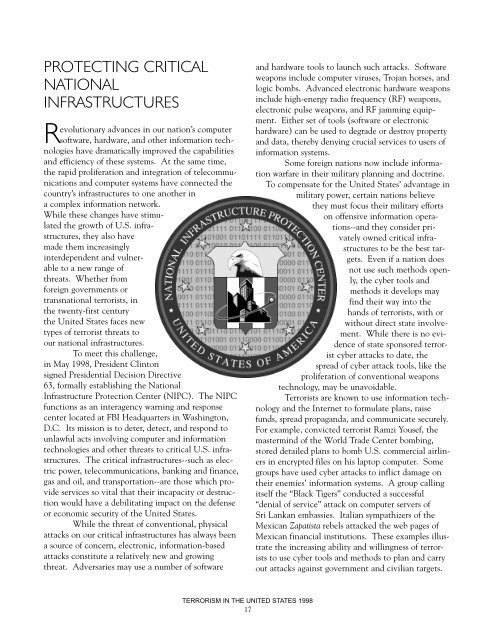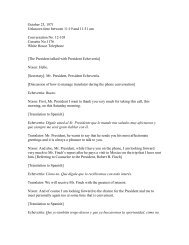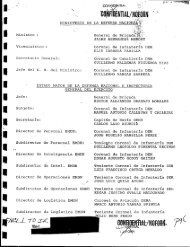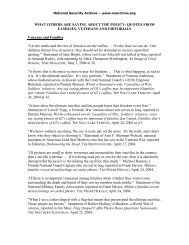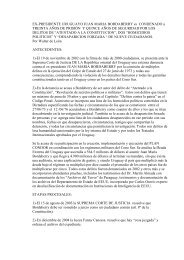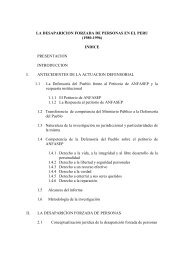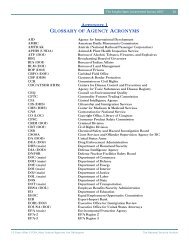TERRORISM 98 - FBI
TERRORISM 98 - FBI
TERRORISM 98 - FBI
You also want an ePaper? Increase the reach of your titles
YUMPU automatically turns print PDFs into web optimized ePapers that Google loves.
PROTECTING CRITICAL<br />
NATIONAL<br />
INFRASTRUCTURES<br />
Revolutionary advances in our nation’s computer<br />
software, hardware, and other information technologies<br />
have dramatically improved the capabilities<br />
and efficiency of these systems. At the same time,<br />
the rapid proliferation and integration of telecommunications<br />
and computer systems have connected the<br />
country’s infrastructures to one another in<br />
a complex information network.<br />
While these changes have stimulated<br />
the growth of U.S. infrastructures,<br />
they also have<br />
made them increasingly<br />
interdependent and vulnerable<br />
to a new range of<br />
threats. Whether from<br />
foreign governments or<br />
transnational terrorists, in<br />
the twenty-first century<br />
the United States faces new<br />
types of terrorist threats to<br />
our national infrastructures.<br />
To meet this challenge,<br />
in May 19<strong>98</strong>, President Clinton<br />
signed Presidential Decision Directive<br />
63, formally establishing the National<br />
Infrastructure Protection Center (NIPC). The NIPC<br />
functions as an interagency warning and response<br />
center located at <strong>FBI</strong> Headquarters in Washington,<br />
D.C. Its mission is to deter, detect, and respond to<br />
unlawful acts involving computer and information<br />
technologies and other threats to critical U.S. infrastructures.<br />
The critical infrastructures--such as electric<br />
power, telecommunications, banking and finance,<br />
gas and oil, and transportation--are those which provide<br />
services so vital that their incapacity or destruction<br />
would have a debilitating impact on the defense<br />
or economic security of the United States.<br />
While the threat of conventional, physical<br />
attacks on our critical infrastructures has always been<br />
a source of concern, electronic, information-based<br />
attacks constitute a relatively new and growing<br />
threat. Adversaries may use a number of software<br />
and hardware tools to launch such attacks. Software<br />
weapons include computer viruses, Trojan horses, and<br />
logic bombs. Advanced electronic hardware weapons<br />
include high-energy radio frequency (RF) weapons,<br />
electronic pulse weapons, and RF jamming equipment.<br />
Either set of tools (software or electronic<br />
hardware) can be used to degrade or destroy property<br />
and data, thereby denying crucial services to users of<br />
information systems.<br />
Some foreign nations now include information<br />
warfare in their military planning and doctrine.<br />
To compensate for the United States’ advantage in<br />
military power, certain nations believe<br />
they must focus their military efforts<br />
on offensive information operations--and<br />
they consider privately<br />
owned critical infrastructures<br />
to be the best targets.<br />
Even if a nation does<br />
not use such methods openly,<br />
the cyber tools and<br />
methods it develops may<br />
find their way into the<br />
hands of terrorists, with or<br />
without direct state involvement.<br />
While there is no evidence<br />
of state sponsored terrorist<br />
cyber attacks to date, the<br />
spread of cyber attack tools, like the<br />
proliferation of conventional weapons<br />
technology, may be unavoidable.<br />
Terrorists are known to use information technology<br />
and the Internet to formulate plans, raise<br />
funds, spread propaganda, and communicate securely.<br />
For example, convicted terrorist Ramzi Yousef, the<br />
mastermind of the World Trade Center bombing,<br />
stored detailed plans to bomb U.S. commercial airliners<br />
in encrypted files on his laptop computer. Some<br />
groups have used cyber attacks to inflict damage on<br />
their enemies’ information systems. A group calling<br />
itself the “Black Tigers” conducted a successful<br />
“denial of service” attack on computer servers of<br />
Sri Lankan embassies. Italian sympathizers of the<br />
Mexican Zapatista rebels attacked the web pages of<br />
Mexican financial institutions. These examples illustrate<br />
the increasing ability and willingness of terrorists<br />
to use cyber tools and methods to plan and carry<br />
out attacks against government and civilian targets.<br />
<strong>TERRORISM</strong> IN THE UNITED STATES 19<strong>98</strong><br />
17


